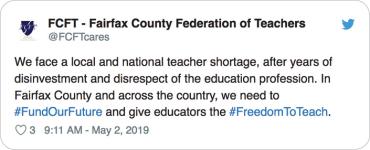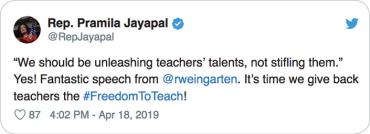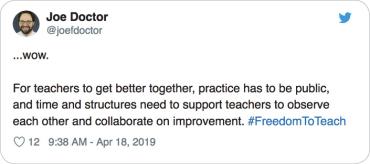In April, AFT President Randi Weingarten spoke at the National Press Club, detailing what she called a “crisis in the teaching profession” and outlining solutions to address it. The following is an excerpt of her speech, which is available in full.
Consider what teachers have recently said about why they teach:
“I teach because I want to change the world, one child at a time, and to show them to have passion and wonder in their learning.”
“I teach so the next generation will question—everything. The classroom should be a place where we set children’s minds free.”
“I teach because our democracy cannot survive without citizens capable of critical analysis.”
Why I felt called to teach is best summed up by this poster I have moved from office to office since I taught in the 1990s: “Teachers inspire, encourage, empower, nurture, activate, motivate, and change the world.”
Teaching is unlike any other profession in terms of mission, importance, complexity, impact, and fulfillment. Teachers get the importance of their work. So do parents and the public. But teachers know that some people don’t get it—whether it’s the empty platitudes, or the just plain dissing. And this has taken a huge toll.
Teachers and others who work in public schools are leaving the profession at the highest rate on record. There were 110,000 fewer teachers than were needed in the last school year, almost doubling the shortage of 2015. All 50 states started the last school year with teacher shortages.
This is a crisis, yet policymakers have largely ignored it.
And it’s getting worse. Enrollment in teacher preparation programs is plummeting—dropping 38 percent nationally between 2008 and 2015.
More than 100,000 classrooms across the country have an instructor who is not credentialed. How many operating rooms do you think are staffed by people without the necessary qualifications? Or airplane cockpits? We should be strengthening teacher preparation programs, not weakening teacher licensure requirements, leaving new teachers less and less prepared. Why are we doing this to our kids?Teaching has become so devalued that, for the first time in 50 years, a majority of parents say they don’t want their children to become teachers.
The challenge is not just attracting people to teaching. The United States must do a much better job of keeping teachers in the profession. Every year, nearly 300,000 leave the profession; two-thirds before retirement age. Attrition in teaching is higher than in nursing, law, engineering, or architecture. Schools serving majorities of students of color and students living in poverty experience the highest teacher turnover rates. Losing so much expertise has an enormous negative impact on students’ education. The financial consequences are also steep—more than $2 billion annually, and that’s a conservative estimate.
It is a failure of leadership to discard so much experience and so much potential—and to lose so much money—to this endless churn.
We are losing the teacher diversity battle as well. A new analysis by the Brookings Institution found that America’s teaching workforce, which is overwhelmingly white, is growing less representative of those they teach, as students of color now make up the majority of public school students.
These statistics reveal an alarming and growing crisis, and it’s well past time we took action.
This crisis has two major roots: deep disinvestment in public education and the deprofessionalization of teaching. America must confront both.
Disinvestment
The teacher uprisings of the last two years have laid bare the frustration over insufficient resources, deplorable facilities, and inadequate pay and benefits for educators. In what President Trump calls the “greatest economy ever,” 25 states still spend less on public education than they did a decade ago. In some states, conditions are so bleak that teachers who previously wouldn’t have dreamed of going on strike feel they have no choice but to walk out to get what their students need.
In 38 states, teacher salaries are lower than before the Great Recession. Research from the Economic Policy Institute shows that teachers are paid 24 percent less than other college graduates. And the stories are all too common of teachers working two or three additional jobs, and even selling their blood plasma, just to get by.
In addition to the soaring cost of healthcare, there is the burden of student loans. The average student loan for a master’s degree in education jumped 82 percent between 2002 and 2012, and the portion of students taking loans grew from 41 to 67 percent over that period. One of the few ways of mitigating this—the Public Service Loan Forgiveness program—has been completely sabotaged by the Trump administration. Teachers are being squeezed in both directions: lower income and higher expenses.
And then there are the conditions in which students learn and teachers teach. Public school facilities got a D-plus from the American Society of Civil Engineers. That means thousands of schools are outdated, unsafe, and unfit, and are literally making people sick.
What does that look like? Rodent infestations in too many schools to count. What does that smell like? Toxic mold throughout schools in Puerto Rico. What does that feel like? Freezing classrooms in Baltimore, when patching up old boilers didn’t work anymore. Don’t tell these kids and their teachers that investment doesn’t matter.
Inadequate funding for education is sometimes the result of weak economies. But more often, it is a deliberate choice—to cut funds for the public schools 90 percent of our students attend—in order to finance tax cuts for corporations and the superrich or to siphon off funds for privatization.
Everything I just described to you is a disgrace. Students know it’s a disgrace. Parents know it’s a disgrace. Administrators know it’s a disgrace. Teachers know it’s a disgrace.
And it is the root cause of the teacher uprisings. And it’s at the heart of the AFT’s Fund Our Future campaign, where we are fighting for adequate investment in public education—from school levies to full funding of Title I and the Individuals with Disabilities Education Act.
Change is happening, like in New Mexico, which has just boosted funding for public schools, and in Illinois and Michigan, where their new governors have pledged to increase investments. But it is shocking that so many politicians do not seem to know it is a disgrace, or at least act like they don’t know.
Deprofessionalization
The disinvestment in public education and the failure of many states to make teaching a financially viable career go hand in hand with another major cause of the crisis we face—the deprofessionalization of teaching.
Ask teachers why they leave the profession. It’s not just underfunding. Teachers are frustrated, demoralized, and really stressed. The lack of classroom autonomy and discretion supercharge that dissatisfaction.
In our online focus groups with teachers from across the country, they spoke about entering teaching excited, optimistic, and determined to make a difference in their students’ lives. And they spoke with equally deep emotion about the stress and disrespect they soon experienced. This deprofessionalization is killing the soul of teaching.
It’s being micromanaged—told that the only decorations allowed in your classroom are the motivational posters provided by a textbook publisher.
It’s worrying about the pacing calendar that requires teachers to follow a predetermined schedule for teaching each topic, even if students need more time to understand the content.
It’s the systemic fixation on standardized testing that dictates virtually every decision about student promotion, graduation, and school accountability, instead of authentic assessments of student learning, like research papers and project-based learning.
Just as the fixation on testing makes teachers’ hair stand on end, so does excessive paperwork—data collection, data entry, and data reporting. One focus group participant summed it up this way: “Teachers are drowning in a sea of paperwork; just let us do our jobs.”
But before one yearns to turn the clock back, there are no halcyon days of teacher professionalism to return to. A century ago, the principles of Taylorism used in factory work were applied to the classroom, with the teacher reduced to the role of unskilled laborer. Decades later, in the age of No Child Left Behind and Race to the Top, prepackaged, corporate curricula were intended to standardize teaching to conform to standardized assessments. Scripted curricula, a.k.a. “teacher proofing,” took restricting teacher discretion to its extreme, not only denying teachers’ creativity and expertise, but assuming their incompetence.
So the fight for professionalism isn’t new—but it has always come from within the teaching ranks, and from our teachers unions.
More than 30 years ago, two powerful ideas that advance teacher professionalism came from the AFT. Our president at the time, Albert Shanker, introduced the idea for the National Board for Professional Teaching Standards, because it is essential to hone and recognize accomplished practice. And, because teachers have always known that the freedom to teach goes hand in hand with credible teacher development, feedback, and evaluation, the idea for improving practice through peer assistance and review originated in our ranks.
Nearly 20 years ago, the AFT’s Albert Shanker Institute released a report on what teachers and other professionals need to succeed. The findings are all too familiar, such as the fact that teachers love their work but are “concerned about conditions on their jobs that deny them the respect, the rewards, the resources ... and discretion in decision-making ... to do their best work.”
And for almost a decade, participants in the AFT’s Teacher Leaders Program have turned their ideas into practice and their advocacy into policy.
While we have been at this work for decades, it has collided with a period in American education of top-down control, test-driven decision making, disinvestment, and teachers being denied authority to make educational decisions. That’s not the case in high-achieving countries like Finland, Singapore, and Canada, where teachers are rightly considered “nation builders,” and their pay, time for collaboration, and involvement in decision making reflect that.
It’s not rocket science to see that the United States has gone in the wrong direction and that we need to reverse course. Teachers need the freedom to teach. If we want our public schools to be all we hope, if we want to attract and retain a new generation of wonderful teachers, this cannot be solely a teacher issue or a teacher union issue. We must act, and act together.
So What Do We Do about It?
Solving this crisis requires treating teachers as the professionals they are.
To change the culture so that the teaching profession is marked by trust, respect, and the freedom to teach, there are aspects we can legislate and we can negotiate.
And that starts by focusing on three essential areas:
- Developing a culture of collaboration;
- Creating and maintaining proper teaching and learning conditions; and
- Ensuring teachers have real voice and agency befitting their profession.
I. Develop a Culture of Collaboration
Developing a culture of collaboration doesn’t happen magically. It requires trust, leadership, and pioneers—all of which are in abundant measure in a district that has become an exemplar for school collaboration—the ABC Unified School District in Los Angeles County. They believe in solving problems, not winning arguments. They know that when teachers and administrators help each other succeed, they help students succeed. This is the ethos guiding other places, as well, including Meriden, Connecticut, and New York City, with its new Bronx Plan.
And the research confirms this. John McCarthy and Saul Rubinstein have researched collaboration in public schools for the past decade. They’ve studied 400 schools in 21 districts in six states. What have they learned?
- Formal labor-management partnerships at the district level lead to greater collaboration at the school level;
- Greater school-level collaboration improves student performance; and
- Collaboration reduces teacher turnover, particularly in high-poverty schools.
Teachers in countries that outperform the United States on international assessments have more time for collaboration and planning each day, and for visiting each other’s classrooms. That’s because these countries understand that preparing to teach is as important as actual instruction.
By contrast, half of the teachers in the United States reported in an extensive international survey that they have never observed other teachers’ classes. They spend more time teaching than educators in higher-performing countries and average an hour less per day for planning and collaboration.
So here’s an idea: build more teacher time into school schedules in addition to individual prep periods—to observe colleagues’ lessons, look at student work, and plan collaboratively.
What else does collaboration do? Collaboration fosters trust, and vice versa. And one of the largest long-term studies of school improvement showed that the most effective schools have high degrees of trust. How do you do that? By sharing information, discussing issues, and solving problems with teachers, which gives them voice and respect as integral parts of a learning organization. This is every bit as important as having a credible system of teacher development and evaluation. So here’s another idea: trust teachers. Develop policies—from the school board to the principal’s office—with teachers, not to teachers.
II. Create and Maintain Proper Teaching and Learning Conditions
For teachers, creating and maintaining proper teaching and learning conditions starts with a simple question: What do I need to do my job, so that my students have what they need?
I could say that class size should be small enough so that teachers and students can form real relationships, so they can delve deeply into projects that interest students, and so students are actively engaged in their learning. But many classrooms don’t even have enough chairs and desks for every student, and teachers often have classes so large that they can’t engage with every child every day, or can’t thoughtfully review and grade their students’ work without having to stay up until 3 a.m.
I could tell you that every classroom should have a state-of-the-art interactive whiteboard. But at the very least, every student and teacher deserves computers that work, along with decent internet. While we’re at it, how about copy machines? With paper!
I could tell you every school should have the necessary wraparound services and enrichment opportunities for students, so that we are meeting every student’s needs. But too often, resources are so limited that we are grateful for a part-time school nurse, overloaded counselors, and castoff athletic gear and musical instruments.
So here’s another idea: ask teachers what they need to do their jobs so their students succeed. Let’s take the answers teachers provide and use them as the basis of an audit of teaching and learning conditions, and then integrate the results into assessments of the district. Ask principals and parents and students as well. Then let’s act on those audit results—through legislation, lobbying, collective bargaining, and, if necessary, school finance lawsuits.
This would be the start of a long-term, sustainable commitment to the necessary teaching and learning conditions for every child in every public school, regardless of demography or geography.
III. Ensure Teachers Have Real Voice and Agency Befitting Their Profession
People like to say they want the “best and brightest” to become teachers. But when teachers start working, they find that, all too often, they don’t get to make consequential decisions. They’re essentially told to check their ideas, imagination, and initiative at the schoolhouse door.
A teacher in one focus group lamented the lockstep regimen at her school—that every class in the same grade must be on the same lesson plan, on the same day, regardless of student need. I hear this constantly.
Do we really want teachers to have to close the classroom door and hope no one “catches” them doing what they think is best for their students? We should be unleashing teachers’ talents, not stifling them. Educators need the benefit of the doubt—the freedom to teach.
The classroom teacher is the only person who has knowledge of the students she is teaching, the content she is teaching, and the context in which she is teaching. What gets taught is determined by district guidelines and curriculum. But how it gets taught is best determined by teachers using their professional expertise and judgment. Teachers meet students where they are, and teachers should have the freedom to find ways to get them to where they need to go.
Scholars Jal Mehta and Sarah Fine spent six years studying American high schools. They found that powerful learning was happening most often in electives, clubs, and extracurricular activities. I found this with my own students, as well, as we prepared for the “We the People” debate competition. We’d spend hours after school—working in teams, deciding their best arguments, practicing, and polishing. We developed deep relationships with each other and a meaningful understanding of the Constitution. Why do we free teachers to run with their ideas after 3 p.m. but rein them in during the school day?
Researcher Richard Ingersoll and his colleagues found that greater teacher leadership and influence in school decision making significantly improve student achievement in both math and English language arts. Yet, despite such evidence, they also found that, in most schools, teachers report having little involvement in school decision making.
Too often, top-down control trumps all else. That hurts students. And it demoralizes teachers.
The assumption should be that teachers, like other professionals, know what they are doing. When teachers are asked—or told—to do something, they should have the latitude to ask two fundamental questions: What is the purpose of what I am being told to do? And how does this contribute to teaching and learning?
Here’s the last idea I’ll offer today: respect teachers by giving them the latitude to raise concerns and act in the best interests of their students without fear of retaliation, as New York City’s United Federation of Teachers negotiated in its latest contract.
The ideas I have outlined are not quixotic fantasies. They are pragmatic strategies that create the sustainable teaching and learning culture that enables the freedom to teach.
These strategies are the reality in high-achieving countries. And they are enabled by the Every Student Succeeds Act, which Congress passed into law with bipartisan support in 2015.
Of course we must call out the austerity hawks, the privatizers, and those who disparage and devalue public education. But let’s build on these two years of incredible educator activism. Let’s bring the proposals I’ve outlined above to the bargaining table, to school boards, and to statehouses. And, if officials speak out of both sides of their mouths—saying teachers and teaching are important but acting as if they are anything but—let’s hold them accountable, not just for their hypocrisy, but for failing to address the real crisis. And, yes, let’s pay teachers appropriately for the tremendously important work they do.
Some say that you can’t negotiate teacher professionalism, that you can’t legislate respect for the teaching profession, that cultures forged over decades of deprofessionalization are too entrenched to change. Talk about being agents of the status quo. Of course change is possible. Many AFT affiliates across the country offer living proof that, where there are willing partners, they are finding ways.
Teachers are drawn to this profession because of their love for children and their passion for teaching. Let’s reignite that passion, not extinguish it. So, to America’s teachers, my heroes who “inspire, encourage, empower, nurture, activate, motivate, and change the world,” I say keep fighting. And keep caring. You are making a difference not only in your classrooms but in reclaiming our profession. The AFT commits everything we’ve got—the resources and influence of our 1.7 million members—to combat this disinvestment, deprofessionalization, and disrespect by fighting to fund our future and to secure the freedom to teach.




